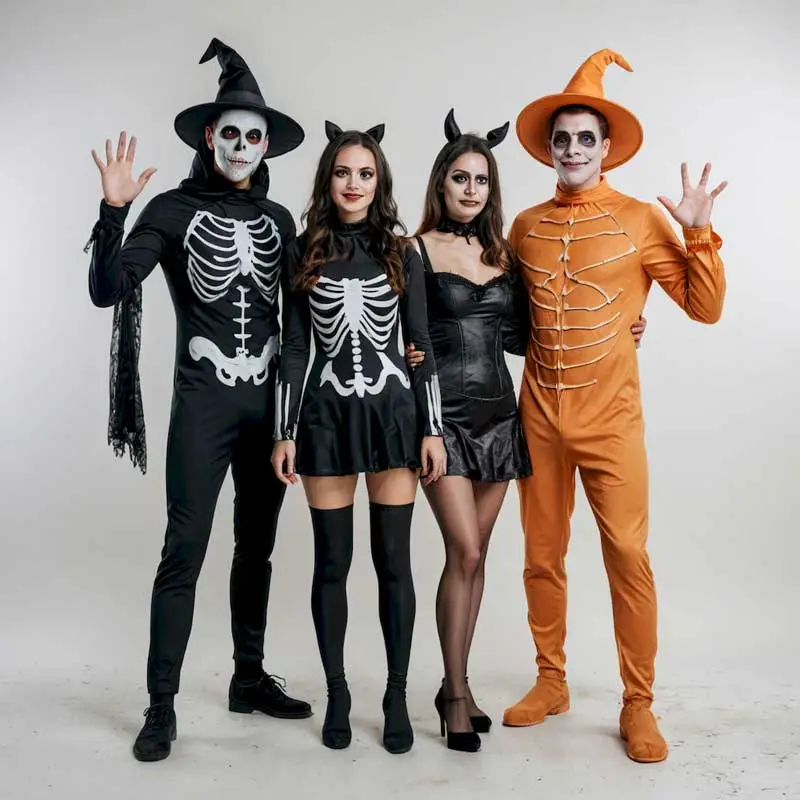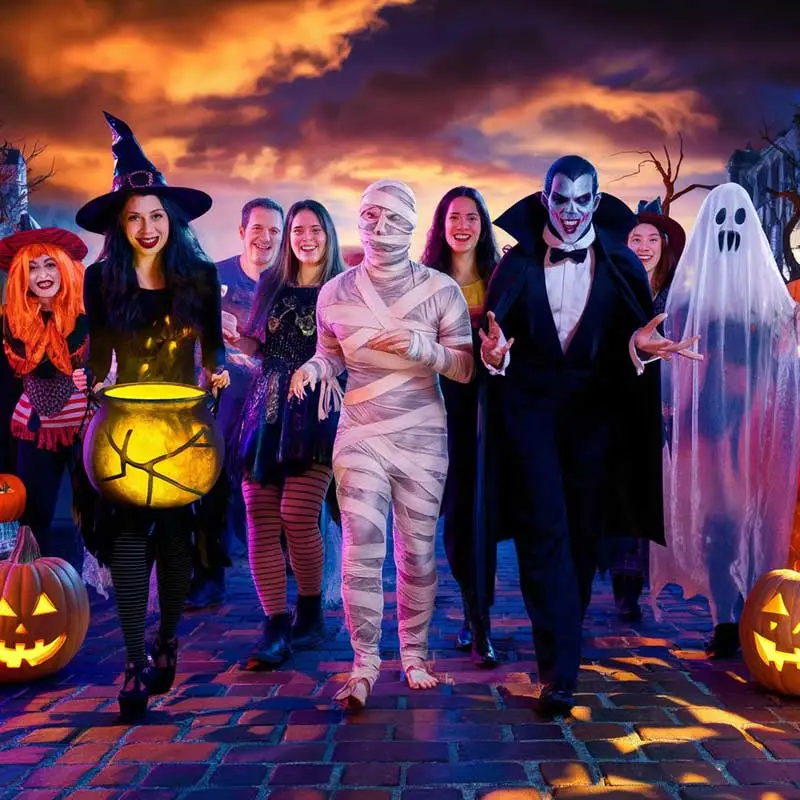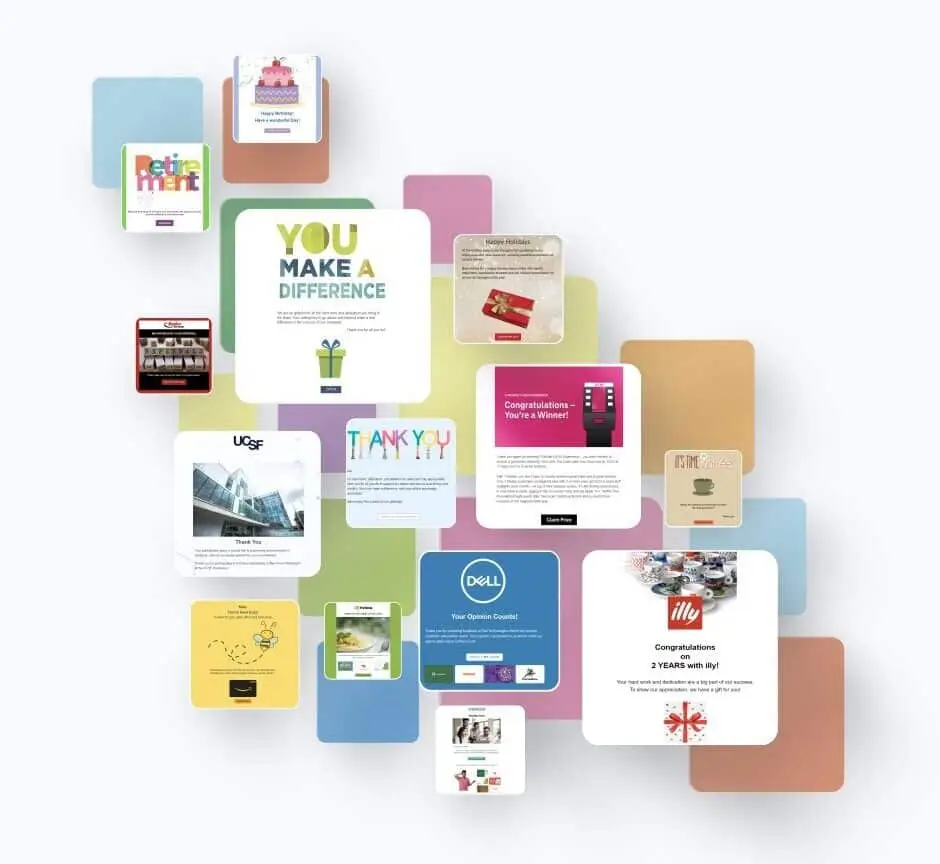Halloween is the perfect time for a workplace celebration and an opportunity to build some fun Halloween engagement. It’s all about celebrating and using the opportunity to increase employee engagement, boost morale and build team spirit.
Employees can dress up in costumes, decorate the office, and share in fun and games.
You can easily include virtual and offsite workers as well.
Halloween-themed events, costume contests, pumpkin carving and friendly competitions all provide fantastic opportunities for team-building and a chance for staff to spend quality time together.
Whether remote or in-person, Halloween brings a sense of excitement, engagement and community, making it a perfect time for organizations to come together and celebrate.
Halloween may well be to most universally celebrated non-religious holiday.
Halloween is a perfect occasion to add some fun to the workplace, unleash some imagination and create an opportunity for teams to bond.
Halloween SWAG bags make great prizes!

Halloween is thought to be the second most popular holiday in the United States.
Halloween has gone global, and the traditions of costumes, candy and trick-or-treating can now be found in nations across the globe.
Halloween falls on a spooky Friday in 2025!
About 72 percent of Americans planned on celebrating Halloween in 2024.
Due the COVID-19 pandemic, the share of Americans who participated in 2020 Halloween activities fell significantly. But it’s come back with a vengeance!
On average, the expenditure on Halloween-related items among U.S. consumers amounts to about 108 U.S. dollars annually. These Halloween related expenditures have more than doubled since 2005.
Halloween traditionally includes a variety of activities, such as trick-or-treating, attending costume parties, or carving pumpkins.

Halloween offers some great opportunities for folks inside and outside the office to participate in the Halloween engagement fun.
In-person events are easy to set up and manage. Remote workers can participate in the fun as well with a little bit of advance planning.
Here are just a few ideas:
Inside the office:
Host a Halloween costume party. Publish a list of winning categories in advance so folks can plan accordingly and go for the gold! Judges can be a mix of company executives and managers as well as an equal mix of line employees. Judging categories can be just about anything; “best individual costume,” “best group costume,” “most original costume,” “best movie-inspired costume,” etc.
Prizes and recognition – for winners, and participants – boosts enthusiasm and adds to the sense of fun and friendly competition.
Outside the office:
Make Halloween fun for remote and virtual workers by having an online costume competition. Costume judging categories should be announced in advance to provide employees an opportunity to do a bit of research and planning. Have them signup in an appropriate judging category. Use online voting to determine winners.
Have folks inside the office participate along with the remote workers as well. Include prizes and participation incentives for remote workers to ensure they are part of the fun.
Inside the office:
Bring in pumpkins and carving tools for individuals or teams. Team up employees for some friendly competition—it’s a perfect way to spark creativity, build camaraderie, and ramp up the fun. As they carve together, team members can share tips, bond, and boost each other’s pumpkin prowess.
Set a time limit, and have your judges score based on a few predetermined, fun categories. Add prizes and participation incentives to take the excitement up a notch!
Outside the office:
Host a virtual pumpkin carving contest for individuals or teams! Bring employees together online for some creative competition and build camaraderie and have fun. Participants can carve before, or during an online session and can share tips and show off their pumpkin skills during the event.
Set a time limit, and have judges score carvings based on a few fun, pre-set categories. Offer prizes and participation incentives to keep the energy high and make the virtual experience exciting
Inside the office:
Have folks decorate their work areas where appropriate or divide into team and decorate a designated work area their workspace with a Halloween theme. Set a specific time limit! This a fun activity that brightens up the office and can also encourage teamwork.
Have a panel of judges and employees to vote for the best Halloween themed decorations. Give out fun gifts for participants and winning teams.
Outside the office:
Who says you can’t decorate for a video conference? This is a great activity for remote workers to join in the fun. Let employees decorate the background of their remote workspace by adding props and backdrops with a Halloween themed. The artistically inclined might develop virtual backgrounds to be included in the judging.
Use the same panel of judges and employees to vote for the best virtual Halloween themed decorations and best virtual Halloween backgrounds. Also include fun gifts for participants and winning teams.
Inside and Outside the office:
A virtual trivia game focused on Halloween-related topics is a perfect way for everyone to participate together. Conduct these in-person or via online video conference. Grab a mix of questions that cater to various aspects of Halloween — from classic Halloween movies to Halloween traditions. Conduct the contest in 10-question blocks and have folks write down answers. Participants self-score when the moderator gives the answers after every 10-question block.
Prizes for most correct answers, and the fewest answers, just to keep it fun!
Inside and Outside the office:
Virtual Escape rooms are great for teamwork and building camaraderie. They encourage players to work together, enhancing collaborative skills. There are several providers that have developed virtual escape rooms and other forms of online collaboration that work as Halloween fun.
Online event choices range from virtual escape rooms to online magic shows to virtual tarot card readings.
Prizes for every participant!
Halloween has a history that can be traced back centuries. Here is brief synopsis.
Ancient Times
Halloween’s origins trace back over two millennia to the ancient Celtic festival of Samhain (pronounced sow-in), celebrated by the Celts of Ireland, the United Kingdom, and northern France. Marking the beginning of the Celtic New Year on November 1st, this festival symbolized the transition from the warmth of summer to the cold and dark winter. It was believed that, on the night before the new year, October 31st, the boundary between the living and the dead grew thin, allowing spirits to cross over into the world of the living. The Celts feared that these spirits could damage crops and wreak havoc, leading them to commemorate the night with sacred bonfires, sacrifices, and costumes designed to blend in with the otherworldly beings.
During these celebrations, Celts burned crops and animals as sacrifices to their gods. Costumes were fashioned from animal skins, and participants would attempt to tell each other’s fortunes, hoping to gain insight into the uncertain months ahead. The belief was that the Druids, or Celtic priests, could make prophetic predictions for the upcoming year, offering comfort as the long, dark winter approached.
Roman Times
With the expansion of the Roman Empire, Celtic territories were conquered, and Roman traditions began to merge with Samhain. Two Roman holidays influenced the evolving celebrations: Feralia, which honored the dead, and a festival dedicated to Pomona, the goddess of fruit and trees, whose symbol—the apple—gave rise to the Halloween tradition of bobbing for apples. These Roman customs, along with Samhain’s rituals, laid the groundwork for the future development of Halloween.
The rise of Christianity in the early centuries A.D. also played a significant role in shaping Halloween. In 609 A.D., Pope Boniface IV established All Martyrs Day in honor of Christian martyrs, and by the 9th century, this observance was expanded to include All Saints’ Day on November 1st and All Souls’ Day on November 2nd. These Christian holidays absorbed elements of Samhain and were intended to replace the pagan festival with a church-sanctioned celebration. November 1st became known as All Hallows Day, and the night before—October 31st—was referred to as All Hallows’ Eve, which later evolved into Halloween.
Modern Era
As time passed, Halloween began its transformation from a spiritual observance into the holiday we recognize today. In the New World, particularly in colonial New England, the celebration of Halloween was limited due to the strict Protestant beliefs of the region. However, in the southern colonies, such as Maryland, communities continued to gather for harvest-related festivities, including sharing ghost stories and participating in fortune-telling activities.
The mid-19th century saw the arrival of millions of Irish immigrants to the United States, many fleeing the Irish Potato Famine. These immigrants brought with them their Celtic traditions, which included customs related to Halloween. One of the most enduring contributions was trick-or-treating, a practice rooted in European customs where individuals would go door-to-door asking for food or money. In America, this custom evolved into children dressing in costumes and asking for candy, solidifying trick-or-treating as a core part of Halloween celebrations.
By the late 19th century, Halloween had largely become a secular holiday centered on community activities, costumes, and seasonal foods. Throughout the early 20th century, Halloween parties for both children and adults became popular, focusing on games, food, and festive gatherings. A cultural shift occurred during this time, with efforts to remove the frightening or grotesque elements from Halloween, transforming it into a more family-friendly event.
Today’s Halloween Traditions
The 1920s and 1930s saw Halloween grow into a community-centered holiday, with large parades and town-wide celebrations becoming common. However, this period was also marked by acts of vandalism, prompting local leaders to shift the focus of Halloween toward children. By the 1950s, with the post-war baby boom, Halloween had evolved into a child-centric holiday, with trick-or-treating moving from towns to homes and schools, making it safer and more accessible for families.
The Halloween of today, while primarily a fun-filled celebration of costumes, candy, and parties, still retains elements of its ancient past. The remnants of Samhain, a festival that once marked the merging of the living and the dead, linger beneath the surface of Halloween’s modern festivities. The traditions may have shifted, but the spirit of the holiday—one rooted in the thin veil between worlds—remains a powerful part of its enduring appeal.
This blend of ancient rituals, Roman influence, along with centuries of cultural evolution, has solidified Halloween as one of the most popular holidays in the United States. Today, Americans spend billions of dollars annually on Halloween, making it the second-largest commercial holiday in the country. While the focus has shifted from spirits and sacrifices to candy and costumes, the history of Halloween remains a fascinating journey through time, a reflection of how societies adapt and reshape ancient traditions into modern celebrations.
Put your teams to the test with a Halloween trivia contest. Trivia contests work great in-person or online.
More Halloween Trivia Questions Here
Q: In what country did Halloween originate?
A: Ireland
Q: In The Addams Family movies, what is the name of the family’s butler?
A: Lurch
Q: What is the most popular Halloween candy in the United States?
A: Reese’s Peanut Butter Cups (according to CandyStore.com)
Q: What vegetable was originally used to carve jack-o’-lanterns before pumpkins?
A: Turnips
Q: In the 1978 movie Halloween, what is the name of the killer?
A: Michael Myers
Q: What was the first American city to host an official Halloween parade?
A: Anoka, Minnesota
Q: Who is the main antagonist in A Nightmare on Elm Street?
A: Freddy Krueger
Q: What is the fear of Halloween called?
A: Samhainophobia
Q: According to superstition, if you see a spider on Halloween, what does it mean?
A: It means a deceased loved one is watching over you.
Q: Which U.S. state produces the most pumpkins?
A: Illinois
Q: What is the name of the villain in The Nightmare Before Christmas?
A: Oogie Boogie
Q: What does the word “hallow” in Halloween mean?
A: Saint or holy person
Q: What classic horror film features the line, “They’re here”?
A: Poltergeist
Q: What animal is associated with witches and Halloween, often considered a bad omen?
A: Black cat
Q: What ghost ship is said to haunt the seas and is often mentioned around Halloween?
A: The Flying Dutchman
Q: In the tradition of “trick or treating,” what was originally given to children instead of candy?
A: Soul cakes
Q: In Hocus Pocus, what are the names of the three Sanderson sisters?
A: Winifred, Sarah, and Mary
Q: In Beetlejuice, how many times must you say “Beetlejuice” to summon him?
A: Three times
Q: What is the name of the hotel in The Shining?
A: The Overlook Hotel
Q: What is the name of the doll possessed by a serial killer in Child’s Play?
A: Chucky
Q: In Scream, what is the name of the town where the killings take place?
A: Woodsboro
Q: Which horror movie features a character named Ghostface?
A: Scream
Q: In Halloween, what is Laurie Strode’s relationship to Michael Myers?
A: She is his sister (revealed in Halloween II).
Q: What item is used to kill vampires in most vampire movies?
A: A wooden stake
Q: What is the title of the 2017 horror movie where characters must remain silent to avoid being hunted by creatures?
A: A Quiet Place
Q: In The Blair Witch Project, what were the characters searching for?
A: The Blair Witch
Q: In It, what form does Pennywise the Clown often take?
A: A dancing clown
Q: In Friday the 13th, who was the original killer before Jason Voorhees took over?
A: Pamela Voorhees (Jason’s mother)
Q: Who played the “original” movie Dracula?
A: Bela Lugosi (1931)

A design session is the perfect way to show you how TruCentive can help you realize your rewards, gifts, or payout goals in a real-world scenario, building a complete project with everything from your logo, design options, and messaging to incentive selection, deliveries, and reminders.
When we’re done, you’ll:


If you’re ready to start designing on your own, sign up and start sending samples. There’s no credit card required to start exploring your creative side!

Use powerful features to quickly create professional-looking incentive deliveries

With a TruCentive subscription, you get technical support for all your team members so you can get back to your project fast

Eliminate the time and frustration managing the procurement, delivery, and management of your rewards and incentives deliveries